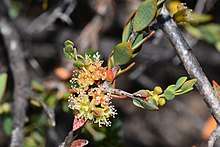Melaleuca pauciflora
Melaleuca pauciflora is a shrub in the myrtle family Myrtaceae, endemic to the south-west of Western Australia. Its decussate leaf arrangement and its small heads of white flowers on the sides of its branches are diagnostic. This is probably the least spectacular of all the melaleucas.
| Melaleuca pauciflora | |
|---|---|
 | |
| Melaleuca pauciflora near Ashendon | |
| Scientific classification | |
| Kingdom: | Plantae |
| Clade: | Tracheophytes |
| Clade: | Angiosperms |
| Clade: | Eudicots |
| Clade: | Rosids |
| Order: | Myrtales |
| Family: | Myrtaceae |
| Genus: | Melaleuca |
| Species: | M. pauciflora |
| Binomial name | |
| Melaleuca pauciflora | |
| Synonyms[1] | |
|
Melaleuca leptoclada Benth. | |
Description
Melaleuca pauciflora is a bushy shrub usually growing to a height of about 3 m (10 ft). Its leaves are in alternate pairs, the pairs at right angles to the ones above and below so that there are four rows of leaves along the stems. The leaves are 3–12 mm (0.1–0.5 in) long and 0.9–2.0 mm (0.04–0.08 in) wide, glabrous and elliptic in shape but tapering towards the end.[2]
The flowers are white, in small heads up to 6 mm (0.2 in) in diameter and contain 2 to 8 flowers. The petals are 1–1.4 mm (0.04–0.06 in) long and fall off as the flowers mature. The stamens are arranged in five bundles around the flower, each bundle with 2 to 7 stamens. Flowers appear in summer and are followed by fruit which are woody capsules 1.5–2 mm (0.06–0.08 in).[2][3]
Taxonomy and naming
Melaleuca pauciflora was first formally described in 1847 by Nikolai Turczaninow in "Bulletin de la Societe Imperiale des Naturalistes de Moscou".[4][5] The specific epithet (pauciflora) is from the Latin words paucus meaning "few" or "little"[6]:489 and flos meaning "flower" or "blossom"[6]:338 referring to the inflorescences which are small and have few flowers.[2]
Distribution and habitat
Melaleuca pauciflora occurs between the Perth area and Albany in the Esperance Plains, Jarrah Forest, Swan Coastal Plain and Warren biogeographic regions.[7] It grows in sand in estuaries, swamps and other winter-wet areas.[8]
Conservation
This species is classified as "not threatened" by the Government of Western Australia Department of Parks and Wildlife.[7]
References
- Govaerts, R. et. al. (2019) Plants of the world online: Melaleuca pauciflora. Board of Trustees of the Royal Botanic Gardens, Kew. Retrieved 12 March 2019.
- Brophy, Joseph J.; Craven, Lyndley A.; Doran, John C. (2013). Melaleucas : their botany, essential oils and uses. Canberra: Australian Centre for International Agricultural Research. p. 273. ISBN 9781922137517.
- Holliday, Ivan (2004). Melaleucas : a field and garden guide (2nd ed.). Frenchs Forest, N.S.W.: Reed New Holland Publishers. p. 222. ISBN 1876334983.
- "Melaleuca pauciflora". APNI. Retrieved 14 April 2015.
- Turczaninow, Nikolai (1852). Bulletin de la Societe Imperiale des Naturalistes de Moscou, Volume 20. Moscou. p. 166. Retrieved 14 April 2015.
- Brown, Roland Wilbur (1956). The Composition of Scientific Words. Washington, D.C.: Smithsonian Institution Press.
- "Melaleuca pauciflora". FloraBase. Western Australian Government Department of Parks and Wildlife.
- Paczkowska, Grazyna; Chapman, Alex R. (2000). The Western Australian flora : a descriptive catalogue. Perth: Wildflower Society of Western Australia. p. 396. ISBN 0646402439.
External links
- Melaleuca pauciflora Occurrence data from the Australasian Virtual Herbarium